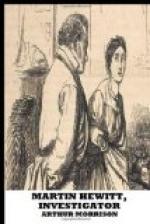“So far so good. But on examining the match very closely I observed, as you can see for yourself, certain rather sharp indentations in the wood. They are very small, you see, and scarcely visible, except upon narrow inspection; but there they are, and their positions are regular. See, there are two on each side, each opposite the corresponding mark of the other pair. The match, in fact, would seem to have been gripped in some fairly sharp instrument, holding it at two points above and two below—an instrument, as it may at once strike you, not unlike the beak of a bird.
“Now here was an idea. What living creature but a bird could possibly have entered Mrs. Heath’s window without a ladder—supposing no ladder to have been used—or could have got into Mrs. Armitage’s window without lifting the sash higher than the eight or ten inches it was already open? Plainly, nothing. Further, it is significant that only one article was stolen at a time, although others were about. A human being could have carried any reasonable number, but a bird could only take one at a time. But why should a bird carry a match in its beak? Certainly it must have been trained to do that for a purpose, and a little consideration made that purpose pretty clear. A noisy, chattering bird would probably betray itself at once. Therefore it must be trained to keep quiet both while going for and coming away with its plunder. What readier or more probably effectual way than, while teaching it to carry without dropping, to teach it also to keep quiet while carrying? The one thing would practically cover the other.




